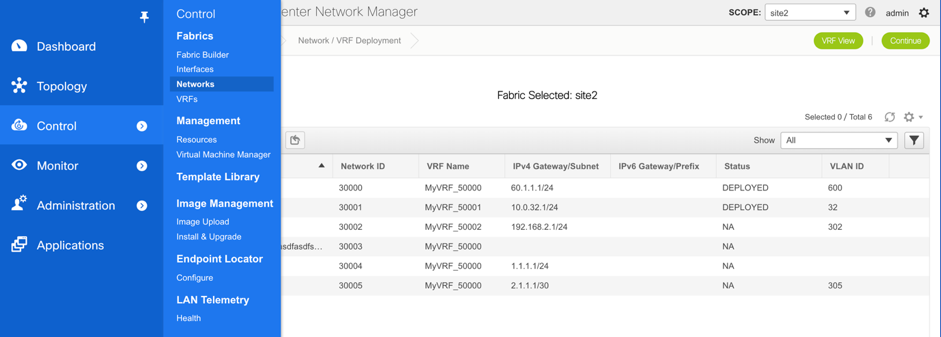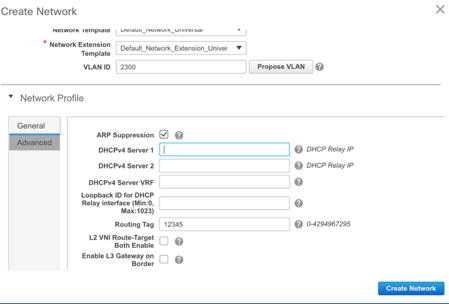































As you might remember from our last post within our DCNM 11 series, we discussed Easy Management of Interfaces using DCNM. Today, we're continuing the discussion by featuring how Cisco's Data Center Network Manager (DCNM) empowers Easy Provisioning of Overlays using pre-defined, best practice, out-of-box templates.
Once the underlay has been deployed via the DCNM fabric builder, overlay-related networks and VRF configurations need to be provisioned on the appropriate devices. DCNM provides simple workflows for provisioning of overlays in multiple fabrics, using flexible, customizable profile templates. Beyond the creation of Networks and VRFs for end-point attachment, Data Center Interconnect (DCI) and external connectivity like Inter-AS Option A (aka VRF-lite) can be configured with minimal user input. Various resources required for Layer-3 hand-off configuration are auto-generated from user-defined pools, making the setup of external connectivity a breeze.
In the case of DCI using VXLAN EVPN Multi-Site technology, DCNM provides a simple way to auto-configure the border gateway and core device peerings. Overlay provisioning workflows have enough built-in intelligence to abstract out the various kinds of underlays and greatly aid the network administrators in the migration of the centralized gateway employed in legacy environments, to the distributed IP anycast gateway in VXLAN EVPN environments.
 Networks and VRFs in DCNM 11.2
Networks and VRFs in DCNM 11.2DCNM allows users to create a Layer-2/Layer-3 Network and its associated VLAN, VRF and VNI, using out-of-box best practice templates. A Layer-2 network can be incrementally migrated to Layer-3 by mapping that Network to an appropriate VRF. DCNM automatically deploys a VRF to a switch when a Layer-3 network associated with that VRF is deployed to that switch. Appropriate references and states are maintained on a per switch, per network and per VRF basis.
For ease of deployment, DCNM provides a "Propose VLAN" option that provides the next available VLAN not being used across all switches within a fabric; this in turn can be mapped to a new Network. Similarly, when multicast is chosen as an option to carry BUM traffic within a given fabric, DCNM manages the user-defined multicast pool and provides flexible options of mapping multicast groups to networks and VRFs. Various configuration knobs are available that can be incrementally added/edited post network creation and/or deployment. These include features such as ARP suppression, IPv6 enablement, secondary gateway IPs, DHCP relays, Tenant Routed Multicast, VXLAN OAM etc.

 Creating Networks in DCNM 11.2
Creating Networks in DCNM 11.2
During Network and VRF deployment, users can select multiple switches at the same time, either through the topology view or the tabular view. With DCNM, the save, preview (optional), and deploy continuum works in the same way for overlays as is the case for any other configuration. With the preview option in the Network and VRF workflow, there is relevant overlay configuration for review before the changes are pushed to the respective switches. The complete history of what changes were deployed by whom, when and where are maintained on a per switch, per interface, per network, and per VRF basis.
 Deploying Networks and VRFs in DCNM 11.2
Deploying Networks and VRFs in DCNM 11.2Networks and VRFs once deployed are seen in a tabular view as well as captured in the Resource Manager, thereby maintaining state of the configurations. This allows DCNM to provide the next set of available overlay resources from user-defined pools thereby preventing any misconfigurations in overlay provisioning. DCNM supports consistent porting of underlay and overlay configurations to a new switch when the RMA workflow is triggered for a faulty switch. Overlay network and VRF configuration are automatically gleaned from switches in an existing VXLAN EVPN fabric when using the powerful brownfield import feature in DCNM.
 List of Networks created using DCNM 11.2
List of Networks created using DCNM 11.2 List of VRFs created using DCNM 11.2
List of VRFs created using DCNM 11.2DCNM allows users to schedule backups at a fabric level where DCNM captures the config and state of each switch, thereby having a complete notion of which Networks and VRFs are deployed where. These come in handy when doing a restore of the configs and state at a fabric level.
In addition to the web-based user interface and REST APIs, DCNM also supports bulk creation of networks and VRFs via a csv file import option with pre-defined overlay network and VRF definitions. To keep changes at hand, all network/VRF definitions including their current and historical deployment status, are available as a report.
If you haven't already done so, check out Day-0 provisioning using Fabric Builder and managing interfaces using DCNM, which serve as a pre-requisite to this blog on overlays.
 Tags quentes :
VXLAN
DCNM
EVPN VXLAN
DCNM 11
VRF
Tags quentes :
VXLAN
DCNM
EVPN VXLAN
DCNM 11
VRF